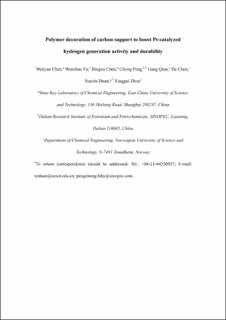| dc.contributor.author | Chen, Wenyao | |
| dc.contributor.author | Fu, W.Z. | |
| dc.contributor.author | Chen, Bingxu | |
| dc.contributor.author | Peng, C. | |
| dc.contributor.author | Qian, G. | |
| dc.contributor.author | Chen, De | |
| dc.contributor.author | Duan, Xuezhi | |
| dc.contributor.author | Zhou, Xinggui | |
| dc.date.accessioned | 2021-02-19T12:41:11Z | |
| dc.date.available | 2021-02-19T12:41:11Z | |
| dc.date.created | 2020-11-10T23:36:44Z | |
| dc.date.issued | 2020 | |
| dc.identifier.citation | Journal of Catalysis. 2020, 385 289-299. | en_US |
| dc.identifier.issn | 0021-9517 | |
| dc.identifier.uri | https://hdl.handle.net/11250/2729252 | |
| dc.description.abstract | Decorating the catalyst support with organic moieties to integrate multiple functionalities into metal particles offers a unique platform to promote the catalytic performance. Here, we report a mechanism-driven strategy to functionalize CNT with dual polymers, endowing the supported Pt catalyst with simultaneously enhanced hydrogen generation activity and durability. Kinetics analysis, multiple characterization and DFT calculations reveal that the PDDA acts as electron-acceptor to capture electrons from the Pt particles toward strengthened adsorption of reactants, while the PVP acts as structure-directing agent to induce the catalyst morphology evolution with a preferential exposure of Pt(1 1 1) active sites. Such electronic and geometric synergy by co-functionalizing PDDA and PVP gives rise to a 3-fold increase in the hydrogen generation activity, together with remarkably improved catalytic durability due to the suppressed adsorption of B(OH)4− over the Pt(1 1 1). The strategy reported here might shed new lights on establishing the functionalization protocols to design carbon supported metal catalysts with the targeted properties. | en_US |
| dc.language.iso | eng | en_US |
| dc.publisher | Elsevier | en_US |
| dc.rights | Attribution-NonCommercial-NoDerivatives 4.0 Internasjonal | * |
| dc.rights.uri | http://creativecommons.org/licenses/by-nc-nd/4.0/deed.no | * |
| dc.title | Polymer decoration of carbon support to boost Pt-catalyzed hydrogen generation activity and durability | en_US |
| dc.type | Peer reviewed | en_US |
| dc.type | Journal article | en_US |
| dc.description.version | acceptedVersion | en_US |
| dc.source.pagenumber | 289-299 | en_US |
| dc.source.volume | 385 | en_US |
| dc.source.journal | Journal of Catalysis | en_US |
| dc.identifier.doi | 10.1016/j.jcat.2020.03.023 | |
| dc.identifier.cristin | 1846752 | |
| dc.description.localcode | © 2020. This is the authors’ accepted and refereed manuscript to the article. Locked until 8/4-2021 due to copyright restrictions. This manuscript version is made available under the CC-BY-NC-ND 4.0 license http://creativecommons.org/licenses/by-nc-nd/4.0/ | en_US |
| cristin.ispublished | true | |
| cristin.fulltext | postprint | |
| cristin.qualitycode | 2 | |

